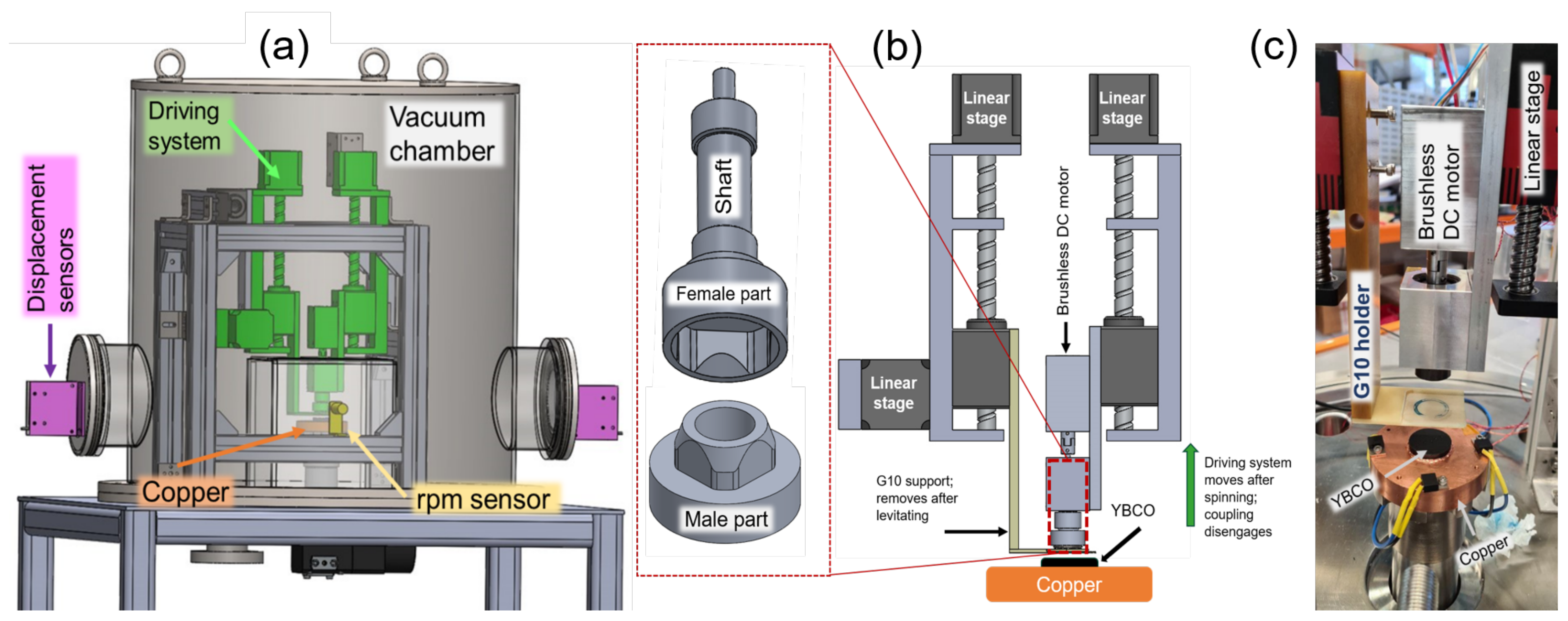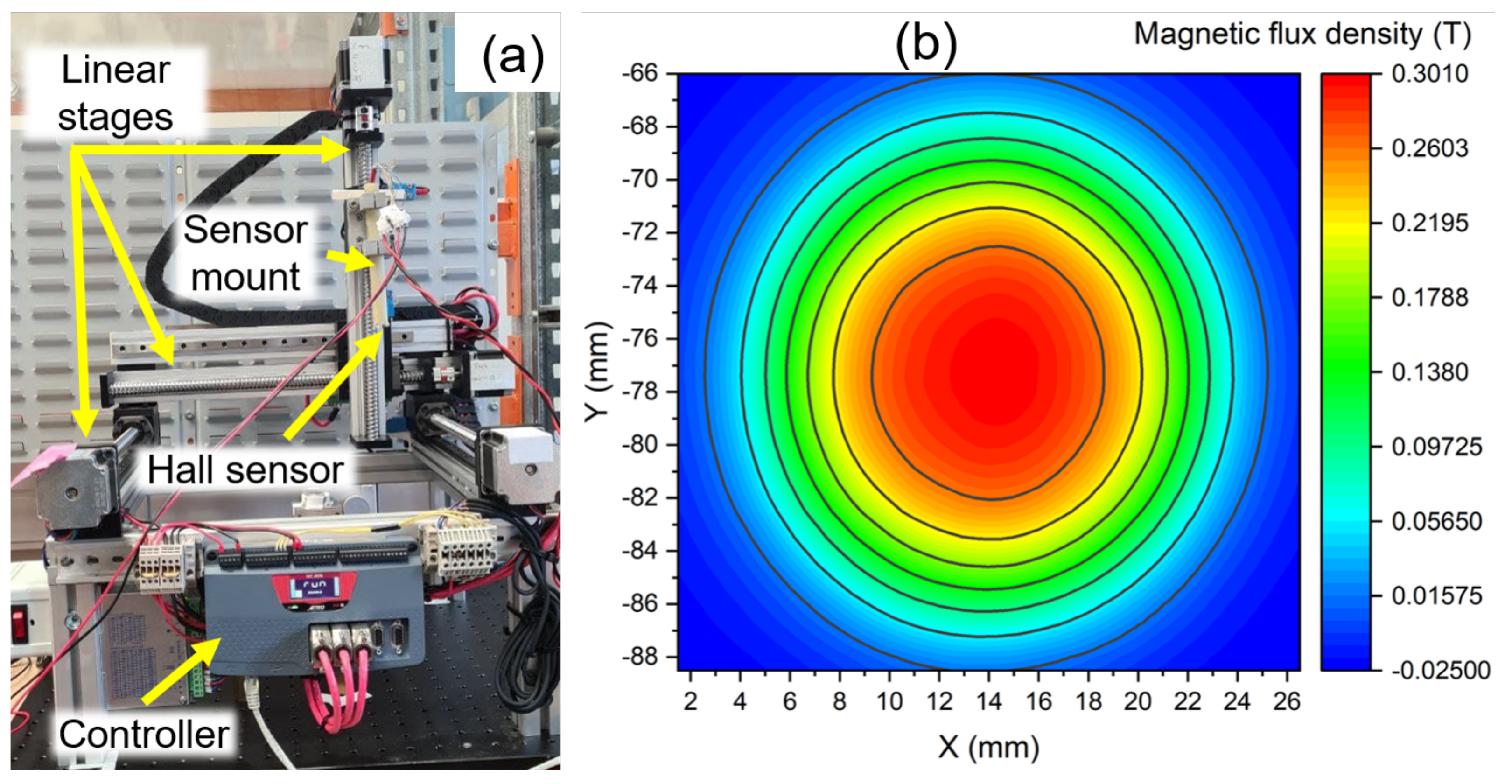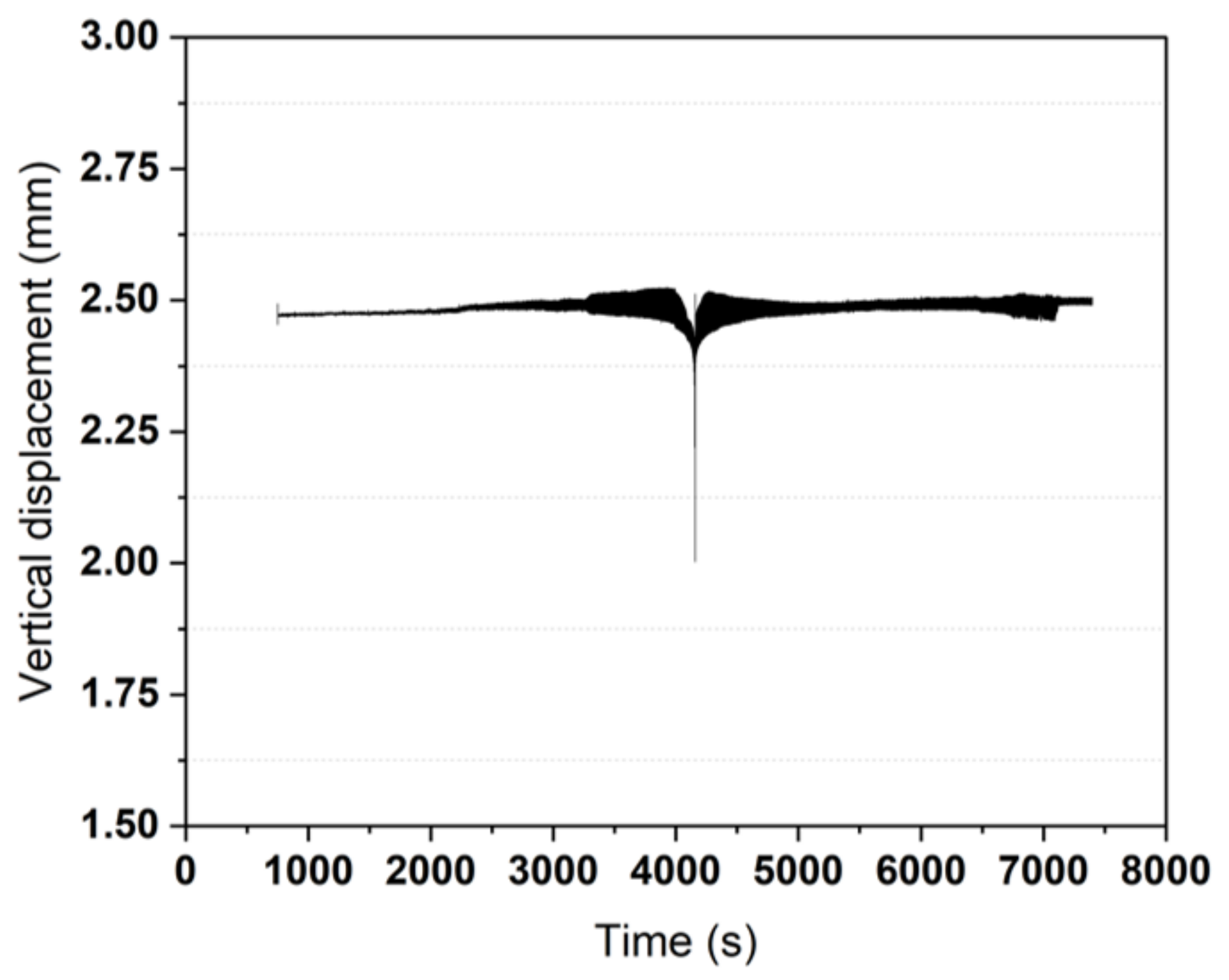Design, Build, and Evaluation of an AC Loss Measurement Rig for High-Speed Superconducting Bearings
Abstract
:1. Introduction
2. Materials and Methods
2.1. Driving System
2.2. Vacuum and Cooling Systems
2.3. Sensors and Measurement Equipment
3. Results and Discussion
4. Conclusions
Author Contributions
Funding
Institutional Review Board Statement
Informed Consent Statement
Data Availability Statement
Acknowledgments
Conflicts of Interest
References
- Kalsi, S.; Hamilton, K.; Buckley, R.; Badcock, R. Superconducting AC Homopolar Machines for High-Speed Applications. Energies 2018, 12, 86. [Google Scholar] [CrossRef] [Green Version]
- Yonnet, J.P. Passive magnetic bearings with permanent magnets. IEEE Trans. Magn. 1978, 14, 803–805. [Google Scholar] [CrossRef] [Green Version]
- Uzhegov, N.; Smirnov, A.; Park, C.H.; Ahn, J.H.; Heikkinen, J.; Pyrhonen, J. Design Aspects of High-Speed Electrical Machines With Active Magnetic Bearings for Compressor Applications. IEEE Trans. Ind. Electron. 2017, 64, 8427–8436. [Google Scholar] [CrossRef]
- Maslen, E.H.; Schweitzer, G. (Eds.) Magnetic Bearings; Springer: Berlin/Heidelberg, Germany, 2009. [Google Scholar] [CrossRef]
- Hull, J.R. Superconducting bearings. Supercond. Sci. Technol. 2000, 13, R1–R15. [Google Scholar] [CrossRef] [Green Version]
- Hull, J.; Murakami, M. Applications of bulk high-temperature Superconductors. Proc. IEEE 2004, 92, 1705–1718. [Google Scholar] [CrossRef] [Green Version]
- Moon, F.C. Superconducting Levitation: Applications to Bearings and Magnetic Transportation; John Wiley & Sons: Hoboken, NJ, USA, 2008. [Google Scholar]
- Riise, A.B. Levitation Force and Magnetization in Bulk and Thin Film High TC Superconductors; Technical Report; Oslo Univ.: Oslo, Norway, 1998. [Google Scholar]
- Earnshaw, S. On the nature of the molecular forces which regulate the constitution of the luminiferous ether. Trans. Camb. Philos. Soc. 1848, 7, 97. [Google Scholar]
- Hull, J.R.; Mulcahp, T.M.; Uherka, K.L.; Erck, R.A.; Abboud, R.G. Flywheel energy storage using superconducting magnetic bearings. Appl. Supercond. 1994, 2, 449–455. [Google Scholar] [CrossRef] [Green Version]
- Terentiev, A.; Kuznetsov, A. Drift of levitated YBCO superconductor induced by both a variable magnetic field and a vibration. Phys. C Supercond. 1992, 195, 41–46. [Google Scholar] [CrossRef]
- Strasik, M.; Hull, J.; Mittleider, J.; Gonder, J.; Johnson, P.; McCrary, K.; McIver, C. An overview of Boeing flywheel energy storage systems with high-temperature superconducting bearings. Supercond. Sci. Technol. 2010, 23, 034021. [Google Scholar] [CrossRef]
- Weinberger, B.; Lynds, L.; Hull, J.; Balachandran, U. Low friction in high temperature superconductor bearings. Appl. Phys. Lett. 1991, 59, 1132–1134. [Google Scholar] [CrossRef]
- Hull, J.R.; Mulcahy, T.M.; Labataille, J.F. Velocity dependence of rotational loss in Evershed-type superconducting bearings. Appl. Phys. Lett. 1997, 70, 655–657. [Google Scholar] [CrossRef]
- Han, Y.; Hull, J.; Han, S.; Jeong, N.; Oh, J.; Sung, T.H. Losses of superconductor journal bearing. AIP Conf. Proc. 2004, 710, 1899–1905. [Google Scholar] [CrossRef]
- Hull, J.R.; Mulcahy, T.; Uherka, K.; Abboud, R. Low rotational drag in high-temperature superconducting bearings. IEEE Trans. Appl. Supercond. 1995, 5, 626–629. [Google Scholar] [CrossRef]
- Ye, M.; Yang, W.; Liu, Y.; Li, Y.; Yu, L. A Design Method of HTS Bulks Array for Decreasing Rotation Loss in a Superconducting Maglev Microthrust Stand. IEEE Trans. Appl. Supercond. 2018, 28, 1–5. [Google Scholar] [CrossRef]
- Lee, J.P.; Han, S.C.; Park, B.C. Experimental estimation on magnetic friction of superconductor flywheel energy storage system. J. Magn. 2011, 16, 124–128. [Google Scholar] [CrossRef] [Green Version]
- Cansiz, A.; Campbell, A.; Coombs, T. An Evershed type superconducting flywheel bearing. Phys. C Supercond. 2003, 390, 305–310. [Google Scholar] [CrossRef]
- Cansiz, A.; Hull, J.R. Stable load-carrying and rotational loss characteristics of diamagnetic bearings. IEEE Trans. Magn. 2004, 40, 1636–1641. [Google Scholar] [CrossRef]
- Jin, S.; Yincai, Z.; Xing, B.; Xiang, G.; Jihao, W.; Qing, L. Simulation and calculation on rotation loss of high temperature superconducting bearings. Phys. C Supercond. Its Appl. 2020, 568, 1353565. [Google Scholar] [CrossRef]
- Hikihara, T.; Adachi, H.; Moon, F.C.; Ueda, Y. Dynamical behavior of flywheel rotor suspended by hysteretic force of HTSC magnetic bearing. J. Sound Vib. 1999, 228, 871–887. [Google Scholar] [CrossRef]
- Day, A.C.; Hull, J.R.; Strasik, M.; Johnson, P.E.; McCrary, K.E.; Edwards, J.; Mittleider, J.A.; Schindler, J.R.; Hawkins, R.A.; Yoder, M.L. Temperature and frequency effects in a high-performance superconducting bearing. IEEE Trans. Appl. Supercond. 2003, 13, 2179–2184. [Google Scholar] [CrossRef]
- Werfel, F.; Flögel-Delor, U.; Rothfeld, R.; Wippich, D.; Riedel, T. Centrifuge advances using HTS magnetic bearings. Phys. C Supercond. 2001, 354, 13–17. [Google Scholar] [CrossRef]
- Xu, K.x.; Wu, D.j.; Jiao, Y.; Zheng, M. A fully superconducting bearing system for flywheel applications. Supercond. Sci. Technol. 2016, 29, 064001. [Google Scholar] [CrossRef]
- Hull, J.; Strasik, M.; Mittleider, J.; Gonder, J.; Johnson, P.; McCrary, K.; McIver, C. High rotational-rate rotor with high-temperature superconducting bearings. IEEE Trans. Appl. Supercond. 2009, 19, 2078–2082. [Google Scholar] [CrossRef]
- Strasik, M.; Hull, J.; Johnson, P.; Mittleider, J.; McCrary, K.; McIver, C.; Day, A. Performance of a conduction-cooled high-temperature superconducting bearing. Mater. Sci. Eng. B 2008, 151, 195–198. [Google Scholar] [CrossRef]
- Kaya, Y.; Cansiz, A.; Yildizer, I. Driving Mechanism of a Superconducting Magnetic Bearing System. J. Supercond. Nov. Magn. 2012, 26, 1233–1239. [Google Scholar] [CrossRef]
- Cansiz, A.; Yildizer, I.; Oral, E.A.; Kaya, Y. An Effective Noncontact Torque Mechanism and Design Considerations for an Evershed-Type Superconducting Magnetic Bearing System. IEEE Trans. Appl. Supercond. 2014, 24, 22–29. [Google Scholar] [CrossRef]
- Matsumura, T.; Hanany, S.; Hull, J.; Johnson, B.; Jones, T. Magnetic Field Inhomogeneity and Torque in High Temperature Superconducting Magnetic Bearings. IEEE Trans. Appiled Supercond. 2005, 15, 2316–2319. [Google Scholar] [CrossRef]
- Matsumura, T.; Sakurai, Y.; Kataza, H.; Utsunomiya, S.; Yamamoto, R. Magnetically coupled gear based drive mechanism for contactless continuous rotation using superconducting magnetic bearing below 10 K. Phys. C Supercond. Its Appl. 2016, 530, 138–141. [Google Scholar] [CrossRef]
- Mechatronic Drive Systems. Available online: https://www.maxongroup.com (accessed on 20 January 2021).
- Edwards. Available online: https://www.edwardsvacuum.com/en (accessed on 20 January 2021).
- Oxford Cryosystem. Available online: https://www.oxcryo.com/ (accessed on 20 January 2021).
- Keyence. Available online: https://www.keyence.com/ (accessed on 20 January 2021).
- Monarch Instrument. Available online: https://monarchinstrument.com/ (accessed on 20 January 2021).
- S950 Silicon Diode Temperature Sensor Product Folder. Available online: https://www.cryocon.com/S900ProdFolder.php (accessed on 20 January 2021).
- Model 26C High Output Power Temperature Controller Product Folder. Available online: https://www.cryocon.com/M26CProdFolder.php (accessed on 20 January 2021).
- Specialising in the Design and Manufacture of High Performance Hall Sensors. Available online: https://www.ahsltd.com/ (accessed on 20 January 2021).
- Triomotion. Available online: https://www.triomotion.uk/ (accessed on 20 January 2021).
- Clem, J.R. AC losses in high-T c materials. In Advances in Superconductivity X; Springer: Berlin/Heidelberg, Germany, 1998; pp. 23–28. [Google Scholar]
- Siamaki, M.; Storey, J.G.; Badcock, R.A. Towards a Non-Destructive Method of Mapping the E-J Relation Using Force Decay Measurements on Superconducting Bulks. IEEE Trans. Appl. Supercond. 2021, 31, 1–5. [Google Scholar] [CrossRef]





| Parameter | Value |
|---|---|
| Nominal voltage | 48 V |
| No-load speed | 57,300 rpm |
| No-load current | 263 mA |
| Nominal speed | 55,500 rpm |
| Nominal torque (maximum continuous torque) | 25.5 mNm |
| Nominal current (maximum continuous current) | 3.42 A |
| Max. efficiency | 91.6% |
Publisher’s Note: MDPI stays neutral with regard to jurisdictional claims in published maps and institutional affiliations. |
© 2022 by the authors. Licensee MDPI, Basel, Switzerland. This article is an open access article distributed under the terms and conditions of the Creative Commons Attribution (CC BY) license (https://creativecommons.org/licenses/by/4.0/).
Share and Cite
Siamaki, M.; Storey, J.G.; Wiesehoefer, L.; Badcock, R.A. Design, Build, and Evaluation of an AC Loss Measurement Rig for High-Speed Superconducting Bearings. Energies 2022, 15, 1427. https://doi.org/10.3390/en15041427
Siamaki M, Storey JG, Wiesehoefer L, Badcock RA. Design, Build, and Evaluation of an AC Loss Measurement Rig for High-Speed Superconducting Bearings. Energies. 2022; 15(4):1427. https://doi.org/10.3390/en15041427
Chicago/Turabian StyleSiamaki, Mohammad, James G. Storey, Lars Wiesehoefer, and Rodney A. Badcock. 2022. "Design, Build, and Evaluation of an AC Loss Measurement Rig for High-Speed Superconducting Bearings" Energies 15, no. 4: 1427. https://doi.org/10.3390/en15041427
APA StyleSiamaki, M., Storey, J. G., Wiesehoefer, L., & Badcock, R. A. (2022). Design, Build, and Evaluation of an AC Loss Measurement Rig for High-Speed Superconducting Bearings. Energies, 15(4), 1427. https://doi.org/10.3390/en15041427







